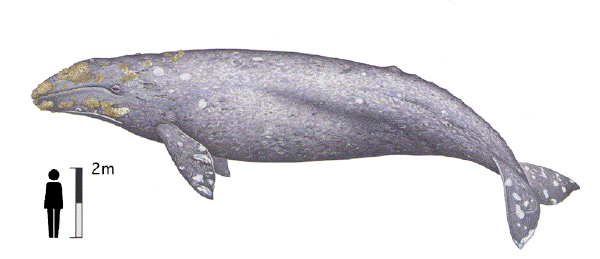The Gray Whale
(Eschrichtius robustus)
The Gray Whale is one of the most active of all large whales with spyhopping, lobtailing and breaching commonly observed. The Gray can grow to a length and weight of 15m (50ft) 30-35 tonnes for the female and 14m (46ft) 16 tonnes for the male. This whale is well known for the 19,500km (12,000 mile) round trip between its northern feeding grounds in the Beaufort, Bering and Chukchi seas and its southern breeding grounds in Baja California and off the Korean coast.

Click here for a bigger Image
The Gray whale is mottled grey over it's entire body including the flippers and tail flukes (though albino individuals are not uncommon). This grey body is covered with white, yellow or orange patches of barnacles and associated parasites (whale lice), particularly on top of the head, around the blowhole and on the anterior part of the back. The head is narrow and arched along the upper surface giving it a conical shape. It's mouth contains small hairs along the upper jaw with 130-180 relatively small baleen plates on each side.
Primarily a bottom feeder, the Gray will dive to 120m (395ft) deep, but prefers much shallower water. While feeding it stirrs up clouds of mud from the seabed and from it's mouth during filtration. During this time the whale will mostly consume tubeworms and sessile polychaetes. While migrating the Gray will feed at the surface on small fish and shrimp-like mysids (Acanthomysis sculpta) but once the Arctic is reached it will consume it's main prey gammarid amphipods.
Family: Eschrichtidae
Other Names: California Gray Whale, Devilfish, Mussel-digger, Scrag Whale
Three populations once existed. One in the North Atlantic was hunted to extinction around 1700; a Korean population in the Northwest Pacific was hunted until 1968 and is now rare; the third, a Californian population in the Northeast Pacific still exists in moderate numbers, 17,000 - 18,000 despite earlier overexploitation.
The Gray whale can be observed in December to April in Mexico, with small numbers in British Columbia, Canada, Washington State, Oregon,and northern California. The main breeding lagoons in Mexico are Ojo de Liebre, Guerrero Negro, San Ignacio, Scammon's and the Magdalena Bay complex.
During April to November the whales inhabit their Arctic feeding grounds in the northern Bering Sea and southern Chukchi Sea.
| Bibliography | Whales on the Net |